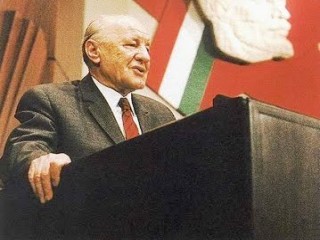
Janos Kádár biography
Date of birth : 1912-05-25
Date of death : 1989-07-06
Birthplace : Lake Balaton, Hungary
Nationality : Hungarian
Category : Politics
Last modified : 2011-07-18
Credited as : Politician, Socialist Workers' Party,
Janos Kádár (original name János Csermanik) was born on May 25, 1912, in a small Hungarian village south of Lake Balaton, the largest lake in central Europe. After attending the village school, he was apprenticed to a toolmaker and was trained as a skilled mechanic.
Kádár began his political career at the age of 19 when he became a member of Hungary's then illegal Communist party in 1931. Said the New York Times in an article in 1956 (October 26), "It was in the harsh conditions of underground work before and during World War II that he came to political maturity." Over the next 12 years, he was arrested several times for illegal party activities. In 1942, he was admitted to the Central Committee of the party and in 1945 to the power-holding Politburo. During World War II he gained hero status for his resistance against the Germans. At one point he was captured by the Nazis, but managed to escape.
Like many other Eastern European Communists, Kádár found it difficult to come to terms with the harsh brand of communism advocated by Russian leader Josef Stalin. Although he seemed destined for high honors when he was named Hungary's minister of the interior in 1948, increasingly, he was found wanting by the Stalinists. In 1950, he was dismissed from both his government post and the party. He was imprisoned the following year and not released until 1954, in the thaw that followed Stalin's death.
Through the years, the Communists had steadily been gaining power in Hungary. On October 23, 1956, a demonstration led by students and intellectuals began the Hungarian revolt against communism and the presence of Soviet troops in the country. As the revolt spread, Communist leaders returned "liberal" Communist Imre Nagy to power to quell the uprising. Kádár joined the short-lived Nagy government, but deserted it when Communist troops took over the country on November 4. Supposedly, Kádár had long been in contact with Soviet leaders, and it is said that he entered the capital city of Budapest riding on a Russian tank.
The new government under Premier János Kádár, under Russian auspices, was announced in 1958. He also served as premier from 1961 to 1965. Kádár pledged an "independent and sovereign" Hungary that would preserve Communist achievements of the past 12 years but also improve the living standard of the Hungarian people.
It was a tall order. The new premier did allow some limited freedom of expression, eased political spying tactics, and permitted greater political tolerance in cultural spheres. But Soviet troops remained and so did the unrest. Hungarians fought Soviet tanks with bare hands. Thousands were killed and more thousands fled their homeland.
In all important matters, Kádár supported Soviet policies. In 1968, Hungarian troops helped to suppress the revolution in Czechoslovakia (now the Czech Republic and Slovakia). As the unrest continued and ties with the Soviet Union remained, Kádár reorganized his government in an attempt to improve the failing economy. As he introduced a partial profit motive into the country, Hungary became the most properous nation in eastern Europe.
After years of walking a tightrope between Communist and democratic policies, Kádár could do no more. The pace of reform slowed and the economy stagnated. Finally, the Soviet Union had had enough. Kádár was removed as general secretary of the Hungarian Communist party in 1988 and given instead the largely ceremonial post of party president. Even that was taken away in May 1989 when he was also removed from the Central Committee. The man who played such a key role in Hungary's transition died two months later in Budapest, on July 6, 1989.
















